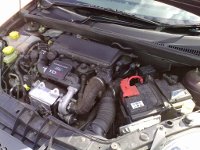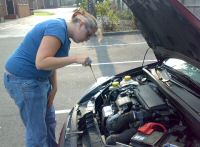Vehicle Safety Questions
 These are basic safety checks that a driver should carry out to ensure the vehicle is safe for use.
These are basic safety checks that a driver should carry out to ensure the vehicle is safe for use.
Although some checks may involve the pupil in opening the bonnet to identify where fluid levels would be checked, you will not be asked to touch a hot engine or physically check fluid levels.

As vehicle technology advances, more and more vehicles are being equipped with electronic diagnostic systems, which inform the driver of the state of the engine fluid levels and tyre pressures. It will be acceptable for a candidate to refer to the vehicle information system (if fitted) when answering questions on fluid levels or tyre pressures.
You will be asked two questions, one 'show me' and one 'tell me'. One or both questions answered incorrectly will result in one driving fault being recorded.
Show Me
- "Open the bonnet, identify where you would check the engine oil level and tell me how you would check that the engine has sufficient oil."
- "Open the bonnet, identify where you would check the engine coolant level and tell me how you would check that the engine has the correct level."
- "Open the bonnet, identify the windscreen washer reservoir and tell me how you would check the windscreen washer level."
- "Open the bonnet, identify where the brake fluid reservoir is and tell me how you would check that you have a safe level of hydraulic brake fluid."
- "Show me how you would check the parking brake for excessive wear."
- "Show me how you would check that the horn is working (off road only)."
- "Show me how you would clean the windscreen using the washers and wipers."
- "Show me /explain how you would check that the power assisted steering is working before starting a journey."
- "Show me how you would check that the direction indicators / hazard warning lights are working."
- "Show me how you would check that the brake lights are working on this car. (Switch ignition but dont start engine)."
- "Show me how you would switch from dipped headlight to main beam. Explain how you would know the main beam is on whilst inside you car."
- "Show me how you would set the demister controls to clear both front and rear windscreens effectively."
- "Show me how you would switch on the rear fog lights and explain when you would use them."
Tell Me
- "Tell me how you would make sure your head restraint is correctly adjusted to provide the best protection in the event of a crash."
- "Tell me how you would check the tyres to ensure that they have sufficient tread depth and that their general condition is safe to use on the road."
- "Tell me how you would check that the brakes are working correctly before starting a journey."
- "Tell me how you would check that the headlights and tail lights are working."
- "Tell me how you would know if there was a problem with the anti lock braking system."
- "Tell me where you would find the information for the recommended tyre pressures for this car and how tyre pressures should be checked."
Click here for a printer friendly version.
